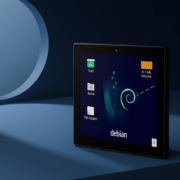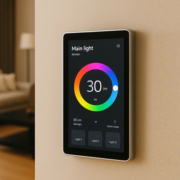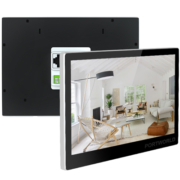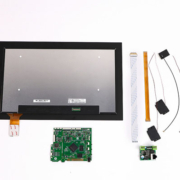Smart Home Touch Screen Control Panel
In the era of smart homes, technology is rapidly transforming how we live and interact with our environments. One of the key devices making this transition smoother and more intuitive is the smart home touch screen control panel. These panels offer a sleek and centralized solution for controlling various smart devices in a home, from lighting and heating to security systems and entertainment devices. In this article, we will explore the features, benefits, and key considerations when choosing a smart home touch screen control panel for your space.
What is a Smart Home Touch Screen Control Panel?
A smart home touch screen control panel is an interface device that allows users to manage and control various smart home systems and appliances through an interactive touch screen. These panels typically run on Android, Linux, or other embedded operating systems, enabling them to support a wide range of apps and services that integrate with smart home devices. The control panels are often installed on walls or placed on surfaces within the home, providing easy access to control all connected systems in one place.
Key Features of Smart Home Touch Screen Control Panels
- Intuitive Touch Interface:
One of the primary features of these control panels is their touch screen interface, which offers a user-friendly experience for managing smart devices. With a simple tap, swipe, or gesture, users can control everything from the lighting ambiance to the temperature in the room. - Integration with Smart Devices:
These control panels can integrate with a variety of smart home devices such as smart thermostats, lights, locks, security cameras, and even entertainment systems like smart TVs or speakers. This centralized control eliminates the need for multiple apps or physical remotes, making it more convenient to manage all aspects of the home automation system. - Customizable Control:
Many smart home touch screen control panels come with customizable layouts, allowing users to create shortcuts for their most-used devices and systems. You can arrange buttons, sliders, and widgets in a way that makes sense for your daily needs, enhancing convenience and efficiency. - Voice Control and AI Integration:
Modern smart control panels often include built-in support for voice assistants like Google Assistant or Alexa, allowing users to control devices through voice commands. With AI integration, some panels can even learn your preferences over time, adjusting settings based on your routine. - Security Features:
Some advanced models of smart home control panels offer built-in security features, such as facial recognition or password protection, ensuring that unauthorized users cannot tamper with your system settings. Additionally, they often integrate with home security systems, providing live feeds from security cameras or notifying you of any unusual activity.
Benefits of Smart Home Touch Screen Control Panels
- Centralized Control:
These panels act as the heart of a smart home system, consolidating control of all connected devices into a single interface. This makes managing multiple devices much simpler and more streamlined. - Convenience:
Having a touch screen control panel installed in a central location—like the living room or entryway—allows easy access for every member of the household. Whether you are adjusting the thermostat, dimming the lights, or monitoring the security system, it’s all done in one place. - Improved Energy Efficiency:
By controlling smart thermostats, lights, and other appliances, you can ensure that energy is being used efficiently. For example, you can program your system to automatically turn off lights when not in use or adjust the heating when the home is empty, reducing energy consumption and saving on utility bills. - Seamless Integration:
These control panels support a wide range of smart home protocols, including Wi-Fi, Zigbee, Z-Wave, and Bluetooth, allowing them to communicate with various smart devices from different manufacturers. This level of compatibility ensures that you can build a smart home with products that fit your needs and preferences. - Enhanced User Experience:
The sleek, modern design of smart home touch screen control panels not only adds a stylish touch to your home but also enhances the overall user experience. Whether you are monitoring the weather, controlling the music, or setting up a movie night, these control panels provide a smooth and seamless interface.
Considerations When Choosing a Smart Home Touch Screen Control Panel
- Screen Size and Resolution:
The size and resolution of the screen are important factors to consider. Larger screens with higher resolutions offer better visibility and make it easier to view multiple controls at once. If you plan to use the panel for video calls or security monitoring, investing in a larger, high-resolution screen will improve the experience. - Compatibility with Existing Devices:
Ensure that the control panel is compatible with the devices you already own or plan to buy. Some panels may be optimized for specific ecosystems (e.g., Google Home, Amazon Alexa), while others support broader ranges of smart devices. - Operating System:
The operating system that the control panel runs on (Android, Linux, etc.) affects the functionality and app compatibility. If you need advanced customization or want to install third-party apps, you may want to consider a more flexible operating system like Android. - Connectivity Options:
Look for control panels that offer various connectivity options, such as Wi-Fi, Ethernet, or Bluetooth, to ensure reliable communication with your smart home devices. Some models also support PoE (Power over Ethernet), which simplifies installation by combining power and data into a single cable. - Design and Aesthetics:
The design of the control panel should complement your home’s decor. Many modern smart home panels offer minimalist designs that blend seamlessly into your home’s aesthetic. Choose one that matches the style and functionality you need.
A smart home touch screen control panel is an essential component of any home automation system. With its intuitive interface, compatibility with a wide range of devices, and ability to centralize control, it simplifies the management of your smart home. Whether you’re looking to improve convenience, energy efficiency, or security, these control panels offer a convenient solution that enhances your smart home experience. By carefully considering your needs and preferences, you can choose the right touch screen control panel to bring your home into the future.










